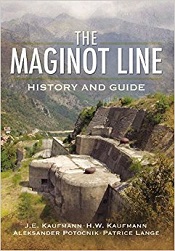The Maginot Line: History and Guide by J.E. Kaufmann, H.W. Kaufmann, A. Jankovič-Potočnik, and P. Lang
Philip Zager

Like the phrase “high-caliber,” the Maginot Line is a physical item for military use that, now, is most commonly used in metaphor. For example, earlier this month, Max Boot, to bolster his claim that Russia Has Invented Social Media Blitzkrieg wrote:
The 2016 U.S. presidential election was as shocking, in its own way, as the fall of France in May 1940. The complacent French thought they were secure behind the Maginot Line until the German panzers penetrated the supposedly impenetrable Ardennes Forest. Likewise the complacent Hillary Clinton campaign thought it was secure because of its hordes of cash, its extensive on-the-ground operation, and the sheer awfulness of its opponent. Surprise! The Russians stole Democratic Party emails and, acting through cutouts like WikiLeaks, leaked the most damaging tidbits. Then social media did the rest. And lo and behold on Nov. 8, 2016, the unthinkable occurred: Donald Trump was elected president of the United States.
Since the Maginot Line’s primary use today is to serve as a metaphor for a “defensive structure that inspired irrational confidence,” (note how Boot chose to describe the French as “complacent”) it would be helpful to understand what the Maginot Line actually was. Fortunately, The Maginot Line: History and Guide by J.E. Kaufmann, H.W. Kaufmann, A. Jankovič-Potočnik, and P. Lang usefully explains the inception and construction of the Maginot Line, the Maginot Line during the Second World War, and the Maginot Line after 1945. The Kaufmanns and their co-authors created a book that is effective as both a history book and a guidebook.
The book’s first section is the glossary, which is helpful because the authors are writing about a French line of fortifications and provide the technical terms in French at the start. This is a fair compromise for less technical readers, who would be lost in the ouvrages and cloches otherwise. The historical chapters have helpful pictures and maps, many of which were taken or drawn by the authors.
The history section begins before the construction of the Maginot Line, pointing to how the question of arranging defenses “was practically settled in the early 1920s with the decision to form an almost continuous line” (13). André Maginot, the French Minister of War beginning in 1929, was the primary supporter of the line and used his “influence to win approval from the French parliament. Many reporters, believing that France was erecting its own version of the Great Wall of China, named the project the ‘Maginot Line’ after its staunchest supporter” (47).
The authors consistently show that this line was only “continuous” in French propaganda. While “the actual ends of the line had to be modified owing to financial restrictions” (46), “the Maginot Line was a huge drain on resources and created only an illusion of security” (46-47) as “propaganda reassured the public with images of an impressive line of battleship-like forts guarding the frontier” (47). However, German intelligence maps were more accurate than the French propaganda maps (121). The authors show that the Great Depression-induced financial constraints led to, by the author’s conservative estimate, actual cost being double the amount authorized. Consistent with the unanticipated cost increase, there was less work completed than planned (51). Moreover, the French “were loath to build massive fortifications along the Franco-Belgian border, even if such works were practical, for fear of offending their ally” (53). The most important undefended area was the Ardennes Forest, where the French did not want to offend the Belgians, the Belgians did not want to invest in their Walloon population, and both parties believed that the Ardennes was effectively impassible (53, 88).
Beyond the Germans ability to drive through the Ardennes, two other factors limited the effectiveness of the Maginot Line against the Germans. First, the fortifications had no heavy artillery or anti-aircraft guns (83). Second, throughout the 1930’s, the French collaborated with the Czechs on fortification design. This meant that, after Czech territory was ceded to the Germans at Munich, the Germans were able study the Czech forts, including performing weapons tests that helped the Germans prepare to attack the Maginot Line (93).
Beyond the gap in planning and the chasm between propaganda and reality, the French had a shortfall in bureaucratic effectiveness. The French had more tanks, with at least equivalent capability, than the Germans, but “unlike the [German] officers, the French were not encouraged to use their judgment and act independently. Instead, the French army was more involved in generating paperwork” (99). This commentary on bureaucracy is another example of how the authors effectively use context to explain why the Maginot Line was ineffective.
Most people aware of the Maginot Line are familiar with its unanticipated irrelevance during World War II. German officers, using their autonomy and knowledge of the fortifications gained from experiments on Czech forts, had no interest in assaulting the fortifications (116). Beyond going through the “impassible” Ardennes, the Germans deployed bombers and paratroopers, which “spread terror like wildfire among the French troops” (120). In many cases, French soldiers were stuck on the Maginot Line has the Germans advanced far beyond to line to Paris and Dunkirk.
The authors show that individual engagements of the Maginot Line for “most of the Maginot fortress troops became a matter of honor” (138). For example, Germans fired 3,000 rounds, all over 100mm, at one outpost, named Schoenenbourg, which refused to surrender during the bombardment (149). Outpost Schoenenbourg, by the time of its surrender, was irrelevant to the larger campaign, but it illustrates the occasional acts of individual bravery of the much-maligned French army. On the Southern part of the Maginot Line, the French, fighting from their fortresses, successfully held off an Italian invasion (163). The Maginot Line, where engaged directly, served its purpose by holding territory effectively.
After World War II, the French again faced other financial obligations that diverted funds from the Maginot Line, especially due to the Algerian War (180). Despite the advent of nuclear weapons, the French maintained several outposts along the Maginot Line until the French finally abandoned all fortifications at the end of the Cold War. The key figure from this time, Philippe Truttman, was “to the preservation of the Maginot Line as Maginot himself was to the creation of the fortifications” (182).
This book is fascinating as a history of a key string of fortresses. Additionally, its final section is a practical guidebook for visiting the sites today. Beyond explaining what can currently be seen, this section features both plans and perspectives for these sites. This is tremendously helpful in understanding what can be seen, how the different parts of given forts interact, and how the forts mesh with the surrounding landscapes.
This book shows that the Maginot Line is more than a metaphor for poor planning. It remains a physical series of structures that can still be visited. More importantly, it shows how economic and political pressure, combined with belief in one’s own propaganda, can be more damaging to national defense that enemy mortar shells.
The views expressed in this review are those of the reviewer and do not reflect the view of the World Bank Group, its Board of Directors, or the governments they represent.
About the Author(s)
Comments
The Maginot Line, an array…
The Maginot Line, an array of defenses that France built along its border with Germany in the 1930s, was designed to prevent an invasion. Built at a cost and visit site now for today's dollars, the 280-mile-long line included dozens of fortresses, underground bunkers, minefields, and gun batteries.The Maginot Line was a vast fortification that spread along the French/German border but became a military liability when the Germans attacked France in the spring of 1940 using blitzkrieg.
This is a new book by experts and has mixed review on Amazon UK.
That aside I have been to two parts of the line, in Alsace-Lorraine and in the Alps on the Italian border, around Briancon. They are often curious lumps of concrete and steel on the surface, now minus field works and barbed wire. Some are open to the public, run by local groups of enthusiasts and once by a Franco-German group.
Having been to the WW1 battlefields further north it is easy to see why France opted for such a defensive policy - concrete and steel instead of blood.

